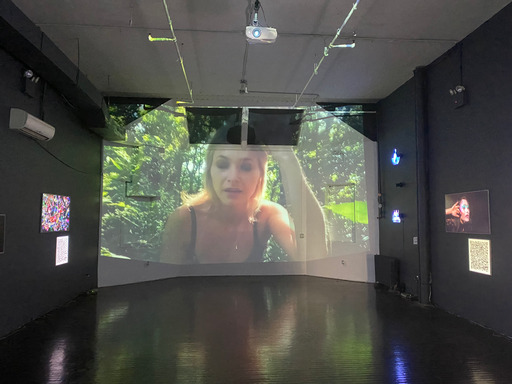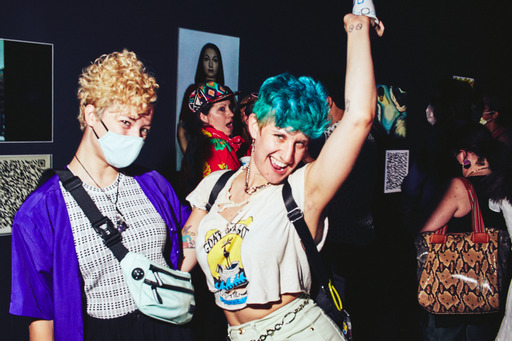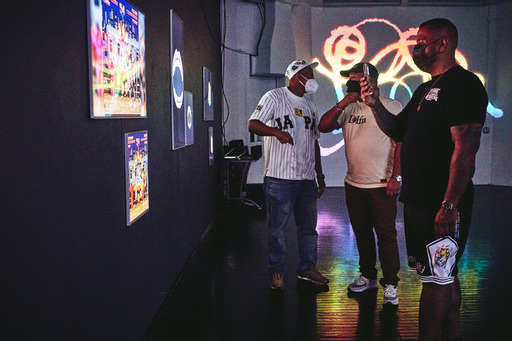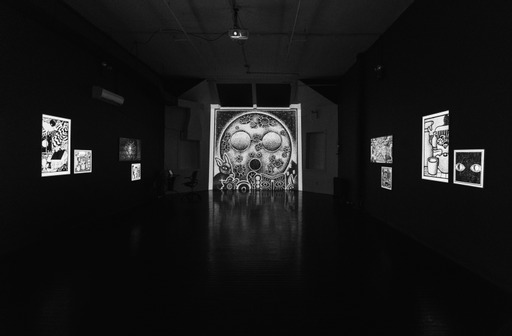We’re once again joined by none other than Superchief Gallery NFT’s Ed Zipco! We’re excited to talk with him again in our ongoing NFTS.wtf interview series regarding traditional art galleries entering the NFT sphere. Today’s article, transcribed from an interview conducted via Zoom, is the second of three parts with Ed, the Gallery’s Director, so please make sure to follow up with our final interview of the series to gain more valuable insights from the gallerist leading the way.
Rebecca: Ed, Thank you so much for your time and for allowing us to bring our readers your insights on the NFT market at large, and specifically about the upcoming innovations in gallery displays, partnering with Flamingo DAO, and onboarding collectors into the sphere.
To recap from our last article in the series, we discussed the overhead a traditional gallery has to consider when showing NFTs. Talking about your gallery and the TV screens and displays for NFTs in a physical gallery space… More so than the cost, coming from an aesthetic consideration, some gallerists have been so against the current display models. Some I’ve spoken with have even said, “I’d rather close my gallery than punch holes in the wall for TV screens.”

Ed: But didn’t they punch holes to hang artwork before? God forbid a sculpture walked into the room! Punch holes in the wall? Are they a landlord or a gallery?
Rebecca: Good point, good point. Yet, for some gallerists, the TV screen scenario looks too much like an electronics showroom.
Ed: You’re taking the words right out of my mouth! That was the big purpose of our new partnership. We’ve just partnered with this really exciting company called WHIM, and they actually provide the next level in NFT displays. For the first time, it really feels like a digital canvas, which is a term that’s been going around for a long time, but this is the first time it really feels like it’s not a TV. It’s really cool. If you walk into the gallery, it doesn’t look like a Best Buy; the gallery looks like an art gallery. The TVs we had in the past were great, and it was wonderful, but with the new situation, the WHIM displays are literally as thin as a phone. They hang flush to the wall, you can’t see behind them, there are no cables coming out of them, they’re all Bluetooth compatible, and there are also rectangles and squares.
Rebecca: So you don’t have black bars on the tops or sides of the work?
Ed: Yeah, no black bars. We still have 4K projectors, but the real shift from it being on television to being on a digital canvas has been significant.
Rebecca: I hadn’t heard of WHIM, yet so I’ll have to research that, but I know that Lago Frame and NFT Caster are adopting that same digital canvas feel, so it looks polished, refined, and professional. Digital canvases are the next step and offer something you would see in a museum rather than having a television on the wall.

Ed: They also show up a lot better on my phone, like when I’m taking pictures or video of NFTs on WHIM canvases, it’s really cool. A significant upgrade. Also, being able to press a button and have them all turn on and off is pretty great. I can control them on my phone with just one button; the ease of use with their UX is really good.
Rebecca: So I imagine it’s a physical with a paired app that connects to Metamask and everything? Very cool.
Ed: Theirs isn’t running off the Metamask yet. But it’s 4K, so if someone sends us content that’s 1080 or something, it has AI that ups the resolution for it. It’s tight – really, really tight—real future shit.
Rebecca: Wow! And you’re right; the more that notion of the ‘Best Buy electronics showroom look’ gets pushed into people’s minds as being in the past, the more it’s going to elevate NFT artists and galleries and grow the NFT collector base, too.
Ed: Absolutely. Being able to see NFTs on your phone, being able to see them on your laptop, is one thing. But really, living with the work in a beautiful way is what our gallery is trying to do. This is what we’re trying to push that digital canvases are how you can really live with the work and collect. Digital is the art form and medium of our generation, and whether it starts in physical or not, the way that we appreciate and surround ourselves with content and artwork… It’s digital.

Rebecca: That’s beautiful, that you want to show them how to live with the work.
Ed: Thank you, that’s very much our ethos on this. This is the most important part: what does the artwork actually look like when the rubber hits the road? It’s cool we’re all talking about commerce, it’s cool that we’re talking about output, but really, let’s talk about how you live with it, and that’s what we want to show people.
Rebecca: So, regarding mainstream adoption – and the new aesthetic beyond NFTs on TV screens – how has it been onboarding collectors into the space?
Ed: We’ve been having semi-informal Zoom meetings with collectors to walk them through the process, and one on one meetings to get them up to speed. That’s been really important. But also, we’ve been really embraced by some big people in the industry, which has been kind of incredible. We were one of the first curators for Flamingo.
Rebecca: Oh! Flamingo DAO, I love them! (https://flamingodao.xyz/)
Ed: Yeah, they were wonderful guiding us through entering the space, and they actually ended up investing in the gallery.
Rebecca: That’s great to hear! Well deserved!
Ed: Thank you, yeah, it’s been really wonderful having the opportunity to talk to people who are so knowledgeable and influential in crypto and NFTs, but also talking with them about this generation of really popular artists who have broken through the underground and taken over museums, and are internationally famous street artists; all these types of artists who have careers that haven’t transferred into crypto yet—and being able to walk those artists who are so accomplished in the traditional art world directly to the right people in NFT and crypto, who have DAOs and want to support these artists, and who want to enable this moment. We’re very fortunate and thankful.
Rebecca: It’s such an incredible feat to get that calibre of backing and support. Flamingo DAO is the top, best of the best.
Ed: They’re the OGs; I’ve just been very thankful for the whole thing. It’s been an awesome opportunity. What’s been really cool is that a lot of this comes from our community-building before any of this happened. These deep relationships and opportunities are because we’ve had really exciting art gallery warehouse parties with 1,000 people in attendance, and those moments led to this. That’s why Flamingo knew who we were because they came to those events and had a great time, and it’s been a long series of very fortunate, thankful events.
Rebecca: Brick after brick.
Ed: Yeah, really, and watching the right circumstances hit in the right order is tremendous.
Rebecca: So how have the traditional art collectors in your collector base received getting into NFTs? Have they opened crypto wallets but haven’t yet bought anything? Are they still testing the waters to see where things land?
Ed: They have all opened wallets. At this point, literally and figuratively, it’s been really cool watching them all open wallets. I would say that the enthusiasm is high, yet the movement is really slow. It’s very much a “Yes, we’re getting involved for this much.” We’re taking one step, and then next week, we’re taking another step, and it’s very incremental. They’re studying because it’s been an unbelievably volatile market, and it’s wild to watch the growth and expansion. Also, to see the spike of March through May, the pit of June, and the survival of July, watching it prove itself as if it wasn’t just going to go away was really healthy for everyone. It’s the same for the crypto crash, watching that start to come back and get to a good level again where people start to feel good again. Everything is being watched at the same time. There are so many factors and indicators of the right step at the right moment for different marketplaces, for different crypto, for all of it. That’s why we opened up the consulting arm, to be totally frank. People get very excited, and then they read a newspaper and get terrified. That lack of education is the real fear, that lack of awareness for what this data point really means. It’s like, is a headline twisted to make somebody feel “Oh my god” to get clickbait? Those moments impact the market because people just jump.
Rebecca: It’s true.
Ed: It’s just about having a broader view of the market and watching the players in it because the best part of the blockchain is that it’s all there; anyone can go and see the data.
Rebecca: Everything is public.
Ed: Everything is public; everything is transparent. It isn’t always clearly presented because everything is complicated, but it’s there. It’s been cool watching the industry mature. Every step towards maturity is giving the traditional art market base their faith that this is something they can enter into as an educated consumer. Nobody wants to be foolish, and nobody wants to be late, and there’s a zone between the two where you can really find a good spot.
(End of Part 2 in the Series)
Photos courtesy of Superchief Gallery NFT’s in-house photographer, Neesmith Onzeur
Digital canvases in partnership with WHIM (Website: https://onawhim.com IG: @seeonawhim)
Superchief Gallery NFT is a pioneering NFT gallery located at 56 East 11th Street, NYC. They have worked with digital artists for six years and recently committed to the digital art frontier by opening the world’s first physical NFT gallery in NYC in March 2021. Please visit www.superchiefgallerynft.com and follow them on Twitter at @SuperchiefNFT



